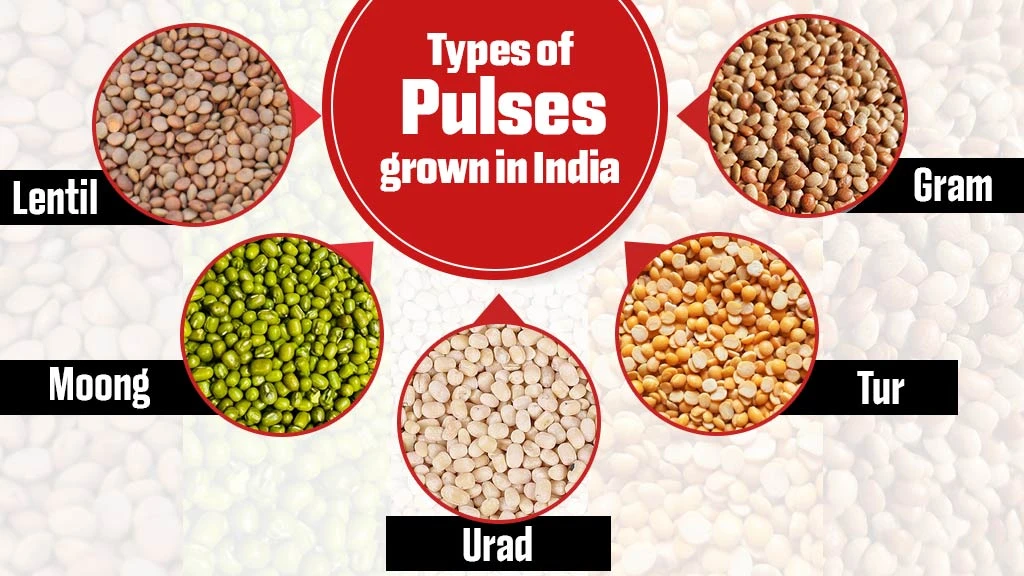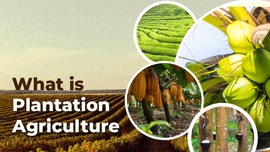Pulses grown in India: Types & Major Producing States

Pulses are one of the essential food crops that contain higher protein content. These are the primary sources of essential amino acids, vitamins and minerals in Indian diets. India is the largest producer and consumer of pulses in the world.
In this blog, we will explore the different types of pulses, the largest producing states of pulses, and the government schemes and initiatives to promote pulse production in India for the betterment of the nation.
Table of Contents
- Introduction to Pulses in India
- Types of pulses grown in India
- Largest Producer of Pulses in India
- Government Initiatives to Promote Pulses Production in India
Introduction to Pulses in India
Pulses are the seeds from the legume family. They come in different shapes, sizes and colours. Pulses are grown in all three seasons: Kharif, Rabi and Summer. India is the largest producer and consumer of pulses in the world. According to the Department of Agriculture and Farmers Welfare, India has 246.56 lakh tonnes of pulse production in 2021-2022. During the last 3-4 years, the production of pulses has increased in India.
Types of Pulses grown in India

|
Type of Pulse |
Producing states |
|
Gram |
Madhya Pradesh, Maharashtra |
|
Toor |
Karnataka, Madhya Pradesh, Gujrat |
|
Moong |
Rajasthan, Orissa, Maharashtra |
|
Lentils (Masoor, Urad and Rajma) |
Gram Dal (Cicer arietinum) is also known as Chana dal or Bengal Gram dal. It is a split and hulled version of chickpeas. It is a staple lentil in Indian kitchens and popular due to its nutty flavor, affordability and rich nutrition. Gram dal is packed with protein, fiber and essential minerals like iron and folate which helps support energy, digestion and heart health. Chana dal is used in many Indian dishes from dal tadka to sweet halwa, crispy vadas and savory pancake. It is majorly grown in Madhya Pradesh, Maharashtra, Rajasthan and Andhra Pradesh. Popular varieties include Gram 1137, PBG 7, Aadhar (RSG-963), Anubhav (RSG 888).
Toor
Toor dal (Cajanus Cajan), is another popular pulse, also known commonly as Arhar dal. It is staple in many Indian meals for dishes like classic dal fry and south India Sambhar. It carries a mild, earthy flavour and smooth texture when cooked. This dal is considered rich in plant protein, potassium, iron, and vitamin B. It is a daily source of nutrition in millions of Indian kitchens. Toor dal is grown widely in states of Maharashtra, Karnataka, Madhya Pradesh, Gujrat and Uttar Pradesh. India grows numerous Toor dal varieties, with some prominent ones including Arhar 1 (ARH-1), Arhar 2 (ARH-2), and Arhar 3 (ARH-3), Pant Arhar 6 (PA 421), and Phule Damayanti (Phule Tur-0723-1-2-3).
Moong
Moong dal (Vigna Radiata) is the split and husked form of mung beans. It is considered light and easy to digest, as well as a powerhouse pulse that can be used in a variety of cuisines ranging from khichdi to moong-dal chilla. It has a delicate, mildly sweet flavour, making it the perfect solid food for babies and a must-have for anyone following a detox diet. It has high quality protein, fiber, antioxidents and folate which is great for weight management and gut health. Popular varieties include SSL 1827, ML 2056, SML 668, TMB 37. Major Moong dal growing states in the country are Madhya Pradesh, Gujrat, Rajasthan, Orissa, Maharashtra, Andhra Pradesh, and Bihar.
Lentils
Here are some other examples of popular lentils grown in India
Masoor Dal (Red Lentils): Masoor dal (Lens culinaris) is widely used in Indian households. It is available in whole (brown) or split (red) form. It cooks quickly and is ideal for simple dals and soups. Masoor is popular in North and East India and prominently Grown in Madhya Pradesh, Uttar Pradesh, Bihar, West Bengal.
Urad Dal (Black Gram): Urad dal (Vigna mungo) is used in both whole and split forms. It is a key ingredient in South Indian dishes like idli, dosa, and vada, as well as North Indian dal makhani. Urad is a lentil rich in Protein, calcium, and iron. It is prominently grown states of Uttar Pradesh, Madhya Pradesh, Tamil Nadu, Maharashtra.
Rajma (Kidney Beans): Rajma (Phaseolus vulgaris), while technically a pulse and not a true "dal," is a key lentil-like legume in North Indian cuisine, especially in popular dishes like Rajma-Chawal. It is Grown in states of Jammu & Kashmir, Himachal Pradesh, Uttarakhand.
Largest Pulses Producing States in India
Madhya Pradesh is the largest pulses producing state in India. Let’s have a look at the top 5 pulses producing states in India.
|
State |
Area (lakh ha) |
Production (lakh tons) |
Yield (kg/ha) |
Major Pulses |
|
Madhya Pradesh |
58.10 |
58.51 |
1007 |
Gram, Urad, Tur |
|
Rajasthan |
60.36 |
39.93 |
662 |
Moong, Arhar, Gram |
|
Maharashtra |
44.05 |
38.22 |
868 |
Tur (Arhar) |
|
Uttar Pradesh |
23.46 |
24.30 |
1036 |
Gram, Urad, Arhar |
|
Karnataka |
31.61 |
19.83 |
627 |
Chickpea, Black Gram, Green Gram |
* DES, Ministry of Agri. & FW (DA&FW), GoI. Normal Area & Prod. (2017-18 to 2021-22).
Government Initiatives to Promote Pulses Production in India
The production of pulses in India has been increasing year by year. In recent years, the total pulses production has increased by 18% in India. The government of India is helping farmers promote India’s pulse production by taking several initiatives. Let us look at some of the initiatives below.
- The Department of Agriculture & Farmers Welfare has launched the National Food Security Mission (NFSM) to increase the production of pulses through area expansion and productivity enhancement.
- Under this mission, the government is providing assistance to the farmers on;
- Cropping, seed production and distribution of high-yielding varieties,
- Improved farm machinery,
- Water application tools,
- Plant protection measures,
- Nutrient management, processing & post-harvest equipment,
- Cropping system-based training, etc.
- Seed mini-kits are provided free of cost to the farmers.
- One hundred fifty seed hubs have been set up under NFSM to obtain quality seeds of pulses.
- The Minimum Support Prices (MSPs) for pulses have been increased in recent years to encourage farmers to grow more pulses.
Frequently Asked Questions On Pulses grown in India: Types & Major Producing States
1. What are the different types of pulses grown in India?
There is a wide variety of pulses grown in India such as Gram, Tur, Lentil and Urad.
2. Which crop is the king of pulses?
Chickpea is considered as the king of pulses.
3. Which state is the largest pulses producer in India?
Madhya Pradesh is the largest producer of pulses in India.
4. In which season are pulses grown?
Pulses are grown in all three seasons: Kharif, Rabi and Summer.


Related Blogs












